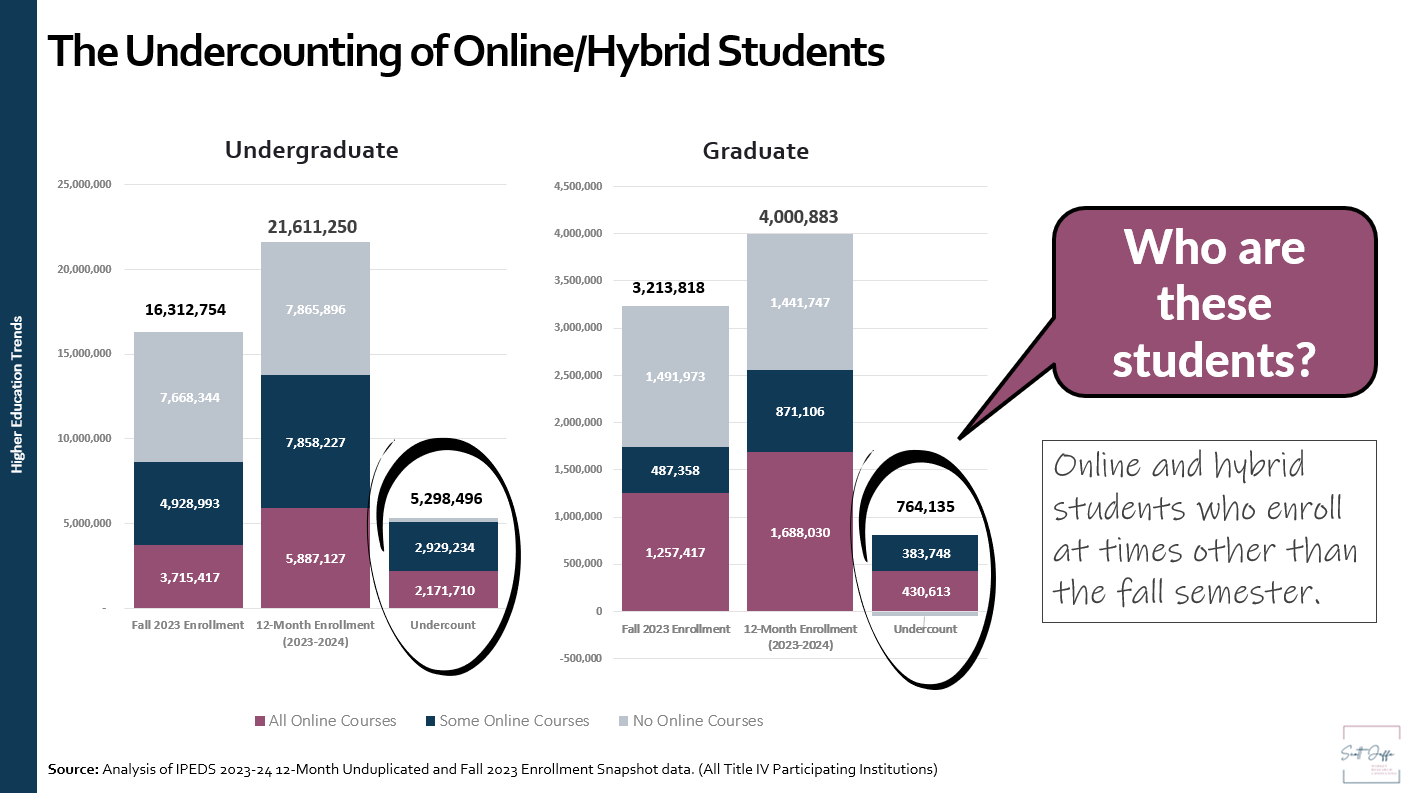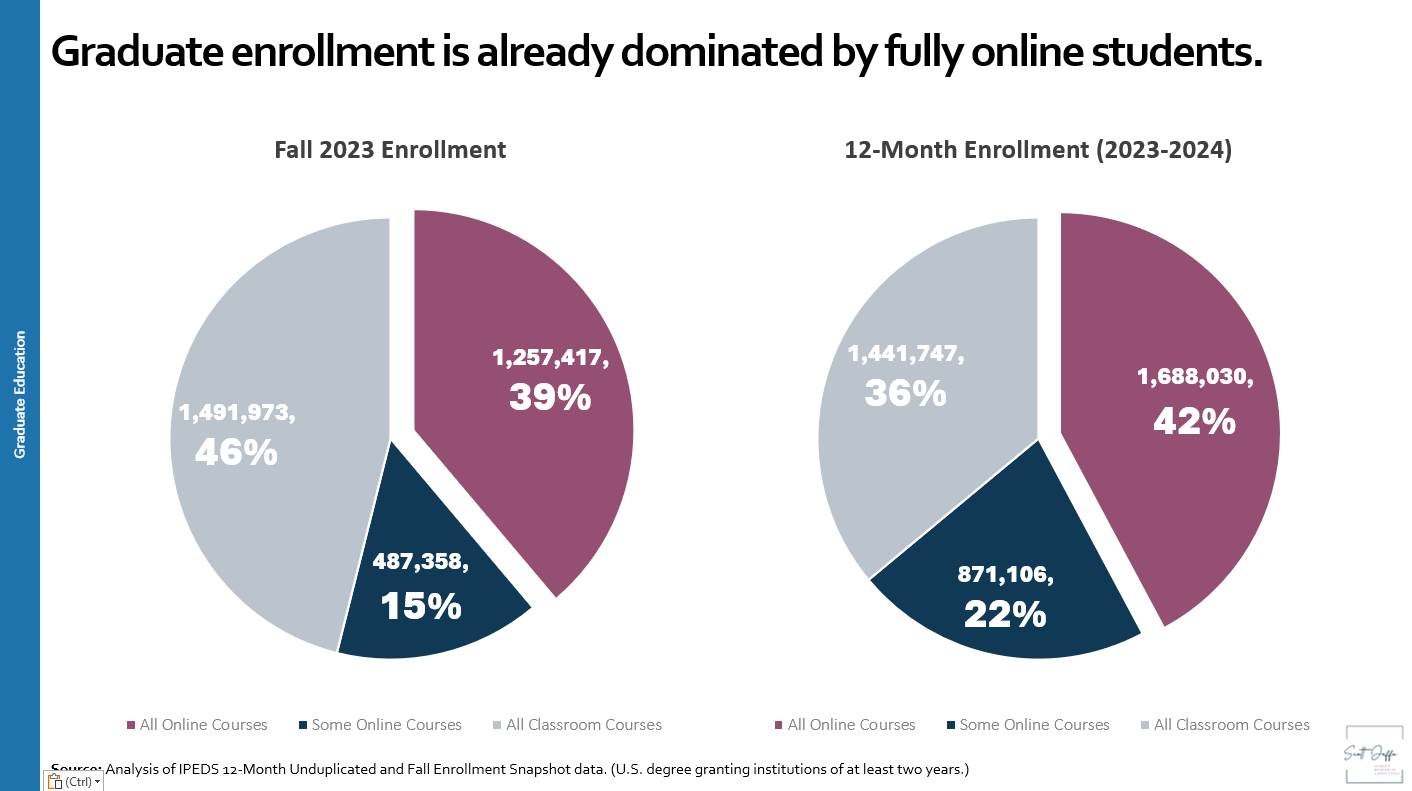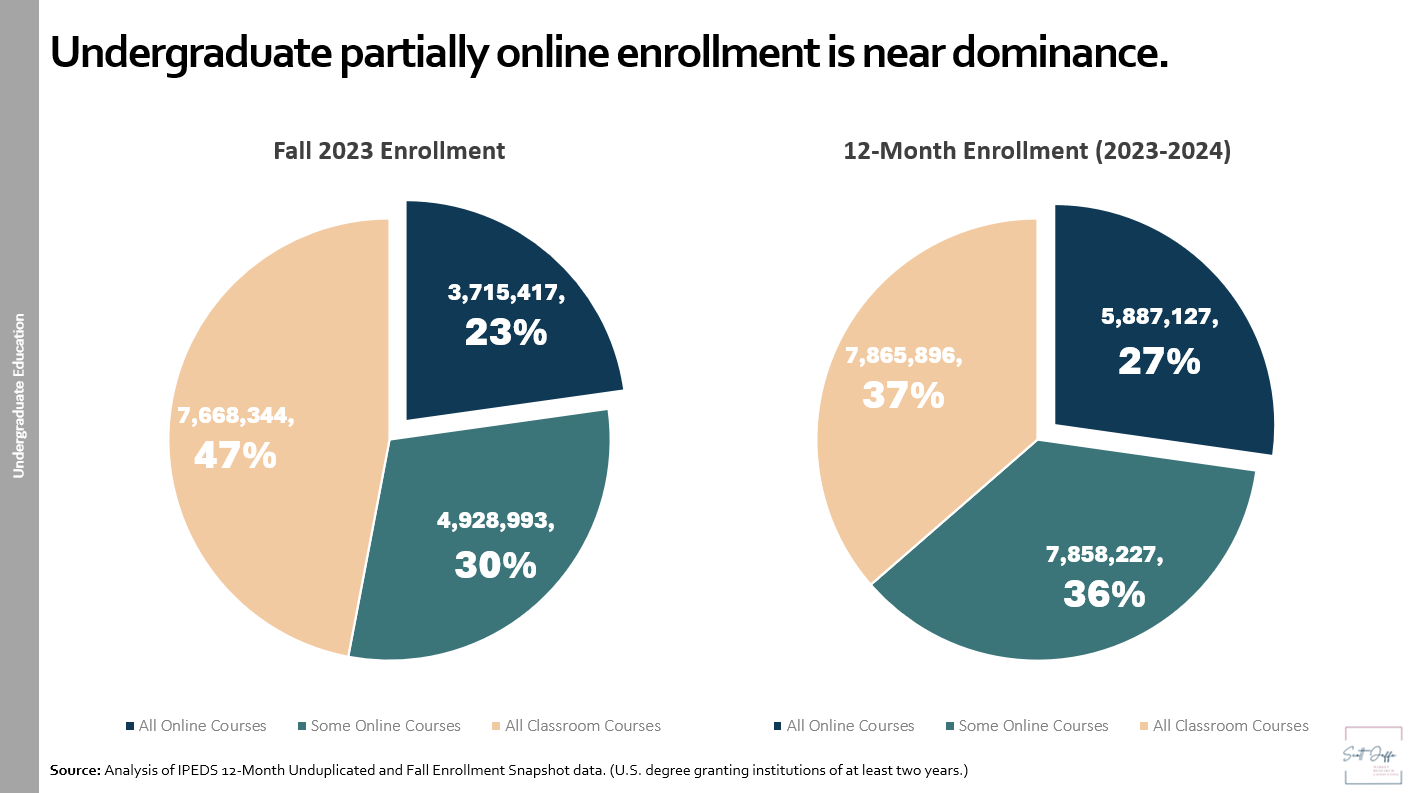
Is Online The Answer? Yes, but the Details Differ for Undergrad and Grad Programs
We still have a few weeks until the release of Fall 2025 enrollment data from National Student Clearinghouse and months until the release of the Fall 2024 snapshot data from IPEDS. The Clearinghouse data will give us insight into the impact of the last nine months, while the IPEDS data (being from fall 2024) will provide us with an understanding of the foundation on which all of 2025’s challenges will sit.
In the meantime, the higher ed press is filled with both success stories and cautionary tales. On September 10th, Inside Higher Ed reported on Fall 2025’s Unexpected Enrollment Successes, and on September 23rd they ran a story on International Enrollment Down at Regional Publics, Small Privates. We won’t know the full impact for a little longer.
Although everyone waits for the Fall enrollment snapshot data, for graduate, online, and adult enrollment IPEDS' full academic year unduplicated data released late last month provides better insights. Why? While almost all traditional undergrads enroll in the fall, online, grad, and adult students enroll throughout the year. More on that below. So, on what foundation will institutions be building in Fall 2025?
Watch my explanatory video of these data here.
Total Academic Year (23-2024) Enrollment Tells the Story
Massive numbers of students are enrolling (in online and hybrid) and times other than Fall. More than 764k graduate students and nearly 5.3m undergraduate students enrolled at time other than the fall semester – and ALL of the graduate students and nearly all the undergraduates enrolled in fully or partially online programs.

2. Undergrads enroll in hybrid study in massive numbers after Fall. Fall undergraduate data undercounts propensity to enroll in fully online study by about 200,000 students, but that undercount grows to nearly 3 million students who are choosing a mix of online and classroom courses.
3. Graduate students enroll in fully online study in massive number after Fall. Fall graduate data undercounts propensity to enroll in programs offering both classroom and online courses by nearly 400,000 students and students who enroll in fully online study by more than 430,000.

4. Fully online is already dominating the graduate market. Full academic year graduate data prove that students choosing fully online study already comprise the greatest proportion (42%) of the graduate education market. Fall enrollment snapshots have regularly indicated that online still lags behind fully classroom (39% v. 46%), but that is only because classroom students are most likely to enroll at the “traditional” starting time.
As noted above, more than 430k graduate students enroll in all online courses at times beyond the fall semester, and nearly as many (more than 400k) enroll in hybrid study including both classroom and online courses.

5. Hybrid programs (offering both online and classroom courses) will soon overtake classroom-only undergraduate programs. While fall data continue to indicate a strong “lead” for classroom-only programs (enrolling 47% v. 30% for hybrid programs), this is only because those most likely to choose a classroom program are those that are in a “seat” when the fall census is taken. Over the course of the full academic year, undergraduate students are choosing programs that offer both classroom and online courses in nearly the same numbers as classroom-only (7.85M v. 7.86M).
Reframing the Narrative: What the Data Tell Us
Context matters: Fall snapshots vs. 12-month enrollments. The IPEDS fall snapshot is a valuable barometer—but not a full measure of online or hybrid demand. The best data to inform decision-making about new program development or current program expansion efforts aimed at enrollment growth are the 12-month, full academic year data.
Institutions seeking undergraduate enrollment growth must vastly increase access to online courses within classroom programs. For undergraduate schools the message is clear: even traditional degree programs must ‘future-proof’ by embedding high-quality online courses widely available to on-campus students. Institutions that lead in course quality, flexibility, and student experience will position themselves ahead of evolving regulatory pressures.
Undergraduate online may look different from graduate online. At the undergraduate level, institutions expanding access to online courses will likely be able to structure these courses in ways that are similar to their classroom offerings – full semester-length, with regular required synchronous sessions, etc. This will be attractive to students in classroom programs that now expect access to online coursework. The challenge here is that undergraduates seeking fully online programs are far less likely to choose a program that is not accelerated and has significant requirements for synchronization. This means that institutions may have to prioritize one audience over the other, and the clear choice for many institutions will be the development of online courses over fully online programs.
Graduate growth is even more clearly predicated on online and hybrid programs than we thought. These data make it clear that, unless an institution has a specific mission, history, or reputation that will make fully-classroom study acceptable to large numbers of students, a growth strategy must be built on aggressive development of online programs and programs that clearly and effectively blend classroom and online coursework. AND, at the graduate level, these programs must all be offered in an accelerated format. There is simply too much “choice” today for students to enroll in programs that do not meet their needs and expectations.
Make your institution discoverable — especially nearby. Surprisingly, geography still matters: in a recent surveys, 40% of online students live within 25 miles of their institution. Yet marketing leaders often underprioritize local search. Most students still begin with a search engine, and if your programs don’t surface in those results, you’re effectively invisible, and with what we have uncovered here about the vast numbers of online students hiding in plain sight, institutions must be sure that students - right in their backyard – know they offer online (and even more specifically hybrid programs at the undergraduate level). Students shouldn’t have to be enrolled before they know that their chosen school or program offers them access to online courses within their program.
If you need help with your online or graduate expansion strategy, I can help. My Readiness Accelerator can help you build the support and the strategies you need in place for success, my Smart Scan can help you ensure you have the right programs, and my Competitor Differentiation Blueprint can help you be sure you know how to differentiate yourself from the pack.